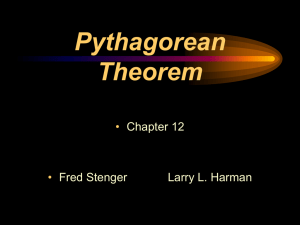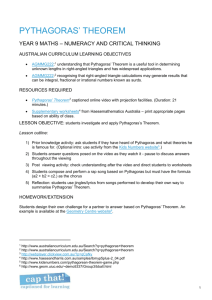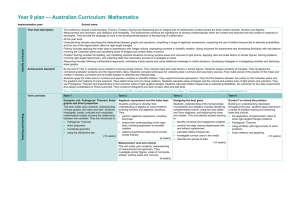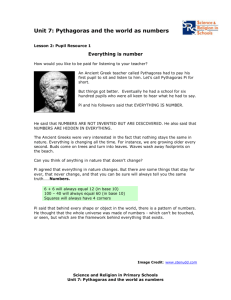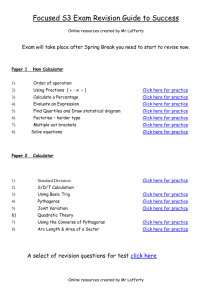Chapter 8 Pythagoras' theorem
advertisement
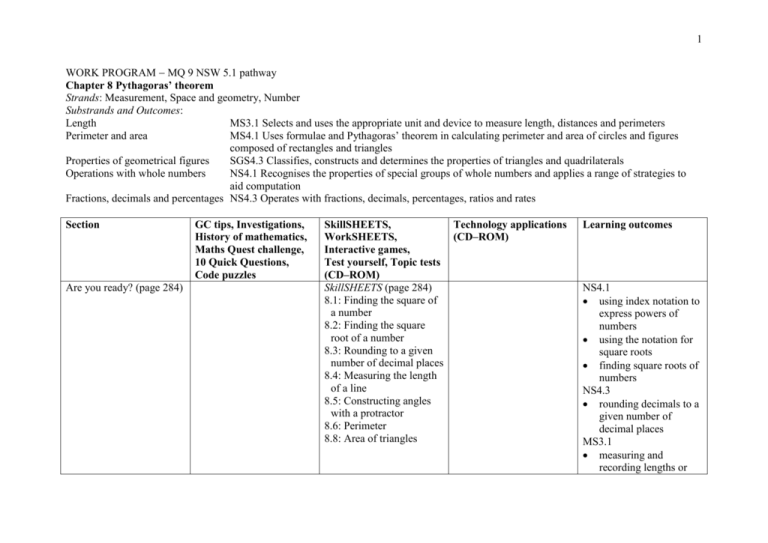
1 WORK PROGRAM MQ 9 NSW 5.1 pathway Chapter 8 Pythagoras’ theorem Strands: Measurement, Space and geometry, Number Substrands and Outcomes: Length MS3.1 Selects and uses the appropriate unit and device to measure length, distances and perimeters Perimeter and area MS4.1 Uses formulae and Pythagoras’ theorem in calculating perimeter and area of circles and figures composed of rectangles and triangles Properties of geometrical figures SGS4.3 Classifies, constructs and determines the properties of triangles and quadrilaterals Operations with whole numbers NS4.1 Recognises the properties of special groups of whole numbers and applies a range of strategies to aid computation Fractions, decimals and percentages NS4.3 Operates with fractions, decimals, percentages, ratios and rates Section Are you ready? (page 284) GC tips, Investigations, History of mathematics, Maths Quest challenge, 10 Quick Questions, Code puzzles SkillSHEETS, Technology applications WorkSHEETS, (CD–ROM) Interactive games, Test yourself, Topic tests (CD–ROM) SkillSHEETS (page 284) 8.1: Finding the square of a number 8.2: Finding the square root of a number 8.3: Rounding to a given number of decimal places 8.4: Measuring the length of a line 8.5: Constructing angles with a protractor 8.6: Perimeter 8.8: Area of triangles Learning outcomes NS4.1 using index notation to express powers of numbers using the notation for square roots finding square roots of numbers NS4.3 rounding decimals to a given number of decimal places MS3.1 measuring and recording lengths or 2 Squares, square roots and rounding (page 285) WE 1a-b, 2a-b Ex 8A Squares, square roots and rounding (page 286) SkillSHEET 8.1: Finding the square of a number (page 286) SkillSHEET 8.2: Finding the square root of a number (page 286) SkillSHEET 8.3: Rounding to a given number of decimal places (page 287) Mathcad: Squares and square roots (page 286) Excel: Squares and square roots (DIY) (page 286) Right-angled triangles (page 287) Ex 8B Right-angled triangles (page 288) SkillSHEET 8.4: Cabri geometry: Measuring the length of a Pythagoras’ theorem line (page 288) (page 289) SkillSHEET 8.5: Constructing angles with a protractor (page 289) distances calculating perimeters of triangles MS4.1 using the formula for the area of a triangle SGS4.3 constructing various types of triangles using geometrical instruments given different information NS4.1 using index notation to express powers of numbers using the notation for square roots finding square roots of numbers recognising the link between squares and square roots MS4.1 identifying the hypotenuse as the longest side in any right-angled triangle and also as the side opposite the right angle establishing the 3 Finding the hypotenuse (page 290) WE 3, 4 Ex 8C Finding the hypotenuse (page 292) 10 Quick Questions 1 (page 294) WorkSHEET 8.1 (page 293) Excel: Finding the length of the hypotenuse (page 292) Mathcad: Pythagoras’ theorem (page 292) GC program – Casio: Pythagoras’ theorem (page 292) GC program – TI: Pythagoras’ theorem relationship between the lengths of the sides of a right angledtriangle in practical ways, including the dissection of areas describing the relationship between the sides of a rightangles triangle (Communicating) SGS4.3 constructing various types of triangles using geometrical instruments given different information recognising that the longest side of a triangle is always opposite the largest angle (Reasoning) MS4.1 using Pythagoras’ theorem to find the length of sides in rightangled triangles solving problems using Pythagoras’ theorem, giving an exact answer as a surd (eg 5 ) and 4 (page 292) Finding a shorter side (page 295) WE 5, 6 Ex 8D Finding a shorter side (page 296) Code puzzle (page 298) SkillSHEET 8.6: Perimeter (page 297) SkillSHEET 8.7: Area of rectangles (page 297) SkillSHEET 8.8: Area of triangles (page 297) Game time 001 (page 297) WorkSHEET 8.2 (page 297) Excel: Finding the length of the shorter side (page 296) Mathcad: Pythagoras’ theorem (page 296) GC program – Casio: Pythagoras’ theorem (page 296) GC program – TI: Pythagoras’ theorem (page 296) approximating the answer using an approximation of the square root writing answers to a specified or sensible level of accuracy, using the ‘approximately equals’ sign using Pythagoras’ theorem to solve practical problems involving right-angled triangles (Applying strategies) MS4.1 using Pythagoras’ theorem to find the length of sides in rightangled triangles solving problems using Pythagoras’ theorem, giving an exact answer as a surd (eg 5 ) and approximating the answer using an approximation of the square root writing answers to a specified or sensible 5 The converse of Pythagoras’ theorem (page 299) WE 7, 8 Ex 8E The converse of Pythagoras’ theorem (page 300) Investigation: Pythagorean triads (page 300) 10 Quick Questions 2 (page 301) Investigation: Pythagoras and the building industry (page 302) Game time 002 (page 300) WorkSHEET 8.3 (page 300) Excel: Right-angle tester (page 300) level of accuracy, using the ‘approximately equals’ sign using Pythagoras’ theorem to solve practical problems involving right-angled triangles (Applying strategies) applying Pythagoras’ theorem to solve problems involving perimeter and area (Applying strategies) MS4.1 identifying a Pythagorean triad as a set of three numbers such that the sum of the squares of the first two equals the square of the third using the converse of Pythagoras’ theorem to establish whether a triangle has a right angle using Pythagoras’ theorem to solve practical problems involving right-angled 6 triangles (Applying strategies) Summary (page 304) Chapter review (page 305) ‘Test yourself’ multiple choice questions (page 306) Topic tests (2)


